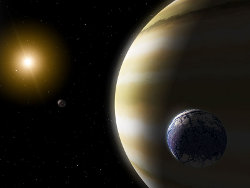I was watching a show about extrasolar planets today, and it made me think of some things.
First, let’s start by saying that the search for planets outside of our own solar system is terrifically exciting – with planets come the possibility of life, and finding life outside our solar system (or, indeed, anywhere outside Earth itself) would be absolutely fantastic.
 A lot of attention is given to the possibility of life-friendly planets, but I see very little attention given to the possibility of life-friendly moons.
A lot of attention is given to the possibility of life-friendly planets, but I see very little attention given to the possibility of life-friendly moons.
For example, we’ve found lots of very large planets around other stars – largely because larger planets are easier to find with the techniques we use. But, often we gloss over these discoveries because they are large planets (like Jupiter) which are considered to have a low probability of life. (They’re also often quite close to their parent star, which means they are quite hot – again, unfriendly for life.)
However, it’s worth remembering that moons of such planets might indeed be the right size and temperature for liquid water to form – and thus, be potentially life-bearing. Indeed, given how common larger planets are, and how larger planets almost always have lots and lots of moons, it stands to reason that it might be more likely to find an “Earth-like” moon than an “Earth-like” planet.
Of course, at the moment we have no real way to detect moons of extrasolar planets – so for the time being, we’ll continue to focus mostly on finding planets, not moons. But once we do get the ability to detect moons (perhaps when we build some larger space-based telescope arrays), I think we’ll make some exciting discoveries when we look at existing larger extrasolar planets with an eye towards finding their moons.
In any case, the search for planets (and moons) outside of our own solar system that might be suitable for life will continue, and these discoveries will continue to astound and amaze us.